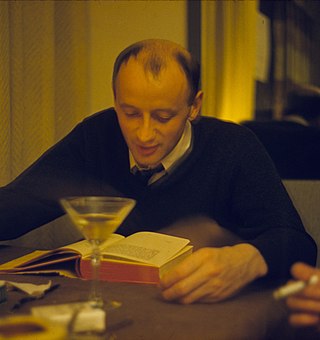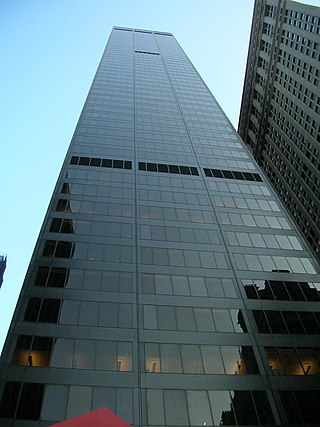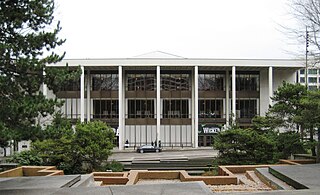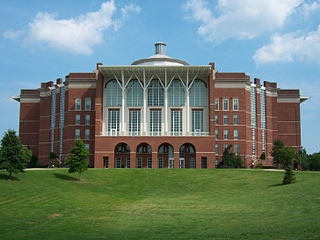Related Research Articles

Minoru Yamasaki was a Japanese-American architect, best known for designing the original World Trade Center in New York City and several other large-scale projects. Yamasaki was one of the most prominent architects of the 20th century. He and fellow architect Edward Durell Stone are generally considered to be the two master practitioners of "New Formalism".

Eamonn Kevin Roche was an Irish-born American Pritzker Prize-winning architect. He was responsible for the design/master planning for over 200 built projects in both the U.S. and abroad. These projects include eight museums, 38 corporate headquarters, seven research facilities, performing arts centers, theaters, and campus buildings for six universities. In 1967 he created the master plan for the Metropolitan Museum of Art, and thereafter designed all of the new wings and installation of many collections including the reopened American and Islamic wings.

The Robert F. Kennedy Bridge is a complex of bridges and elevated expressway viaducts in New York City. The bridges link the boroughs of Manhattan, Queens, and the Bronx. The viaducts cross Randalls and Wards Islands, previously two islands and now joined by landfill.

Paul Goldberger is an American author, architecture critic and lecturer. He is known for his "Sky Line" column in The New Yorker.

The Jefferson Market Branch of the New York Public Library, once known as the Jefferson Market Courthouse, is a National Historic Landmark located at 425 Avenue of the Americas, on the southwest corner of West 10th Street, in Greenwich Village, Manhattan, New York City, on a triangular plot formed by Greenwich Avenue and West 10th Street. It was originally built as the Third Judicial District Courthouse from 1874 to 1877, and was designed by architect Frederick Clarke Withers of the firm of Vaux and Withers.

140 Broadway is a 51-story International Style office building on the east side of Broadway between Cedar and Liberty streets in the Financial District of Manhattan in New York City. The building was designed by Gordon Bunshaft, of the firm Skidmore, Owings & Merrill, and consists of a mostly smooth black facade on a trapezoidal plot. It is approximately 688 feet (210 m) tall, with approximately 1.17 million rentable square feet (109,000 m2). It is known for the distinctive sculpture at its entrance, Isamu Noguchi's Cube.

Boston City Hall is the seat of city government of Boston, Massachusetts. It includes the offices of the mayor of Boston and the Boston City Council. The current hall was built in 1968 to assume the functions of the Old City Hall.

Ada Louise Huxtable was an American architecture critic and writer on architecture. Huxtable established architecture and urban design journalism in North America and raised the public's awareness of the urban environment. In 1970, she was awarded the first ever Pulitzer Prize for Criticism. In 1981, she was named a MacArthur Fellow. Architecture critic Paul Goldberger, also a Pulitzer Prize-winner (1984) for architectural criticism, said in 1996: "Before Ada Louise Huxtable, architecture was not a part of the public dialogue." "She was a great lover of cities, a great preservationist and the central planet around which every other critic revolved," said architect Robert A. M. Stern, dean of the Yale University School of Architecture.

Paley Park is a pocket park located at 3 East 53rd Street between Madison and Fifth Avenues in Midtown Manhattan, New York City, on the former site of the Stork Club. Designed by the landscape architectural firm of Zion Breen Richardson Associates, it opened May 23, 1967. Paley Park is often cited as one of the finest urban spaces in the United States.

Eggers & Higgins was a New York architectural firm partnered by Otto Reinhold Eggers and Daniel Paul Higgins. The architects were responsible for the construction phase of the Thomas Jefferson Memorial beginning in 1939, two years after the death of its original architect, John Russell Pope, despite protests that their appointment had been undemocratic and therefore "un-Jeffersonian". Critics argued a competition should have been held to choose Pope's successor. In 1941, they also completed construction of Pope's other famous design, the West Building of the National Gallery of Art, also in Washington, D.C.

The Cary Building at 105-107 Chambers Street, extending along Church Street to Reade Street, in the Tribeca neighborhood of Manhattan, New York City, was built in 1856–1857 and was designed by Gamaliel King and John Kellum in the Italian Renaissance revival style, with the cast-iron facade provided by Daniel D. Badger's Architectural Iron Work. The five-story twin-facaded building was constructed for William H. Cary's Cary, Howard & Sanger, a dry goods firm.

The Ford Foundation Center for Social Justice is a 12-story office building in East Midtown Manhattan in New York City. Designed by architect Kevin Roche and engineering partner John Dinkeloo in the late modernist style, the building was one of the first that Roche-Dinkeloo produced after they became heads of Eero Saarinen's firm.

Keller Auditorium, formerly known as the Portland Municipal Auditorium, the Portland Public Auditorium, and the Portland Civic Auditorium, is a performing arts center located on Clay Street in downtown Portland, Oregon, United States. It is part of the Portland's Centers for the Arts. Opened in 1917, the venue first changed names in 1966, being renamed again in 2000 in honor of a $1.5 million renovation donation by Richard B. Keller. An extensive remodeling and modernization in 1967–68 effectively changed its original exterior appearance beyond recognition.

The Jacob Riis Houses are a public housing project managed by the New York City Housing Authority (NYCHA) in the East Village in New York City. The project is located between Avenue D and the Franklin D. Roosevelt Drive, spanning two superblocks from 6th Street to 13th Street. The project consists of thirteen buildings, between six and 14 stories each, containing 1,191 apartment units.

Kallmann McKinnell & Wood is an architectural design firm based in Boston, Massachusetts, United States, established in 1962 as Kallmann McKinnell & Knowles by Gerhard Kallmann (1915-2012), Michael McKinnell (1935–2020), and Edward Knowles.
Albert S. Bard was an American lawyer and civic activist in New York City. A graduate of Amherst College and Harvard Law School, he engaged in the practice of corporation and general law until a few years before his death.

The LVMH Tower is a 24-story skyscraper on 57th Street, near Madison Avenue, in Midtown Manhattan, New York City. Designed by Christian de Portzamparc, the building opened in 1999 as the overseas headquarters of Paris-based LVMH Moët Hennessy Louis Vuitton SE. The building has received widespread praise from architecture critics.
Robert Charles Weinberg was an American architect and urban planner. He is mostly known for his projects in his native New York City, particularly relating to parks. He also worked in Chicago and Cleveland.

Donald Harrison Elliott was an American urban planner. He was chairman of the New York City Planning Commission from the late 1960s to the early 1970s. He helped lead the city away from the large-scale disruptive projects of Robert Moses to more neighborhood-friendly and historically respectful development.
Twin Parks is a housing development in the Bronx, New York City. Its buildings were designed by leading architects, and were widely hailed as "the cutting edge of public design" when constructed in the early 1970s.
References
- 1 2 3 4 5 "Club Ending in its 58th Year," New York Times (Feb. 8, 1950).
- ↑ "THE CITY CLUB DISBANDS," New York Times (Feb. 15, 1950).
- 1 2 HOLUSHA, JOHN. "COMMERCIAL REAL ESTATE: REGIONAL MARKET -- Midtown Manhattan; Club and Hotel to Share More Than the Name," New York Times (June 4, 2003).
- ↑ Huxtable, Ada Louise. "Architectural Dynamite: City Club Criticism of Municipal Design Underscores Need for Drastic Reform," New York Times (May 14, 1963).
- 1 2 "The New City Club," New York Times (March 19, 1892).
- 1 2 3 4 5 6 7 Dunlap David. W. "BUILDING BLOCKS: A Goad to the Powerful, Lately Dormant, Is Stirred by a Midtown Zoning Plan," New York Times (August 28, 2013).
- 1 2 "CITY CLUB TO MARK 50TH ANNIVERSARY," New York Times (May 10, 1942).
- 1 2 3 "The City Club's New Home," New York Times (October 3, 1892).
- ↑ "East Providence Historical Society". East Providence Historical Society. Archived from the original on 2013-10-21. Retrieved 2016-04-20.
- 1 2 "CITY CLUB HONOR AWARDED TO MOSES," New York Times (May 22, 1937).
- ↑ Albert S. Bard Papers, Boxes 18, 24, 60-73.
- 1 2 Nichols, Mary Perot. Letter to the Editor: What Really Happened to City Club Broadcasts," New York Times (August 1, 1987).
- ↑ Within, Richard. "CITY CLUB REJECTS ATTACK ON MAYOR: Says Article by Chairman Is Not Official Position," New York Times (November 21, 1967).
- ↑ Ronan, Thomas P. "ROBBINS SAYS BID TO RESIGN FAILED: City Club Trustees Did Not Accept Terms, He Asserts Article Criticized," New York Times (Dec. 7, 1967).
- 1 2 3 WEISMAN, STEVEN R. "CITY CLUB, AT 80, IN BUSIEST YEAR: Plans a Series of Reports on Government Here 23 Awards Presented Charter Revision Cited," New York Times (March 10, 1973).
- ↑ DUNLAP, DAVID W. "Sally Goodgold, Civic Advocate Who Practiced ‘Bagel Diplomacy,’ Dies at 82," New York Times (AUG. 28, 2011).
- ↑ NICHOLS, MARY PEROT. "Letter to the Editor: What Really Happened to City Club Broadcasts," New York Times (August 1, 1987).
- ↑ Bagli, Charles V. (2015-06-12). "Civic Group Sues to Halt Hudson River Park Backed by Barry Diller" . The New York Times. ISSN 0362-4331. Archived from the original on May 21, 2021. Retrieved 2021-05-21.
- ↑ Pham, Diane (2014-11-21). "Opponents of the Pier 55 Floating Park Slap Barry Diller with a Lawsuit". 6sqft. Archived from the original on May 21, 2021. Retrieved 2021-05-21.
- ↑ Oreskes, Michael. "Bombshell Report: After More than 50 Years, Railroads Now Say MSG is "Not Compatible" Atop Penn Station". www.ourtownny.com. Retrieved 2023-06-13.
- ↑ "QUITS CITY CLUB POST: Price, Chairman for 33 Years, Is Succeeded by Sparry," New York Times (Feb. 12, 1944).
- ↑ Stanley Turkel, Built to Last: 100+ Year-Old Hotels in New York (AuthorHouse, 2011), pp. 109–15. ISBN 1463443412
- ↑ "CITY CLUB TO TRY AGAIN; Group of Young New Members to Seek to Revive Organization," New York Times (March 18, 1950).
- ↑ BURKS, EDWARD C. "State's Transit-Bond Plan Is Denounced by City Club: A Defeat Predicted," New York Times (Sept. 25, 1973).
- ↑ Turkel, Stanley. "Paid Notice: Deaths: GOODGOLD, SALLY," New York Times (August 26, 2011).
- ↑ Jessica Marati (2008), "George McAneny". Mudd Manuscript Library of the Princeton University Library. Archived from the original on 2011-06-11. Retrieved March 20, 2011.
- ↑ "Three Empty Places," New York Times (December 16, 1978): "For 14 years he presided over the National Municipal League; he was president of the City Club of New York for 12 years, and Chairman of the Citizens Union for another six."
- ↑ "City Club of New York Elects New President," New York Times (Dec. 5, 1956).
- ↑ "Durable Campaigner: Theodore Roosevelt Kupferman," New York Times (August 22, 1962).
- ↑ "City Club Elects Turkel," New York Times (December 17, 1966), p. 35.
- ↑ "JOSEPH PRICE DIES: LED MITCHEL DRIVE: Head of Successful Campaign for Mayoralty in 1913 Was City Club Executive," New York Times (May 14, 1949).
- 1 2 3 4 PETERSON, ALISON J. "Leon Brand, 74, Who Founded New York Architecture Prize, Dies," New York Times (NOV. 5, 2007).
- ↑ Burnham, Alexander. "CITY HELD FAILURE IN ARCHITECTURE: Club Can't Find a Municipal Building Worthy of Award," New York Times (May 14, 1963).
- 1 2 Burnham, Alexander. "ARCHITECTS SCORE ATTACK ON DESIGN: City Club's Decision Not to Give Civic Award Is Called Misleading and Lazy," New York Times (June 12, 1963).
- 1 2 3 4 HUXTABLE, ADA LOUISE. "Architecture: 6 Designs Win Bard Merit Awards," New York Times (June 14, 1973).
- 1 2 HUXTABLE, ADA LOUISE. "CIVIC CLUB HONORS PRIVATE BUILDING," New York Times (MARCH 17, 1964).
- 1 2 3 "NO BUILDING FOUND TO MERIT CITY CLUB AWARD," New York Times (January 17, 1982).
- ↑ "Albert S. Bard Civic Awards," (Apr 27, 1966), WNYC website. Accessed April 19, 2016.
- 1 2 3 Bird, David. "Bard Awards Made for Four Projects," New York Times (May 4, 1967).
- 1 2 HUXTABLE, ADA LOUISE. "Dissimilar Buildings, Similar Awards," New York Times (May 24, 1970).
- 1 2 "Prizes for Design Go to 2 Universities For Buildings Here," New York Times (June 17, 1971).
- 1 2 HUXTABLE, ADA LOUISE. "Two Buildings Win Design Awards," New York Times (May 19, 1972).
- 1 2 3 Fowler, Glenn. "Bard Awards Honor 8 Examples of Good Urban Design," New York Times (June 12, 1975).
- 1 2 "Urban Oases Hailed in Annual Bard Awards," New York Times (June 16, 1976).
- 1 2 HORSLEY, CARTER B. "ARCHITECTURE AWARD HONORS 8 PROJECTS: New York City Club Singles Out Bronx Development Center and Roosevelt Island Complex," New York Times (June 16, 1977).
- ↑ "17 TO GET AWARDS FOR SERVICE TO CITY," New York Times (October 12, 1967).
- ↑ "Potofsky Is Given Award At City Club Dinner Here," New York Times (October 29, 1969).
- ↑ "CITY CLUB HONORS MRS. MARY LASKER," New York Times (October 21, 1970).
- ↑ "Time Inc. Head to Get Award," New York Times (April 18, 1972).
- ↑ "Moynihan Proposes Reform of Welfare To Revive the City," New York Times (January 15, 1976).
- ↑ "The Harry B. Helmsley Distinguished New Yorker Award," Real Estate Board of New York official website. Accessed Apr. 20, 2016.